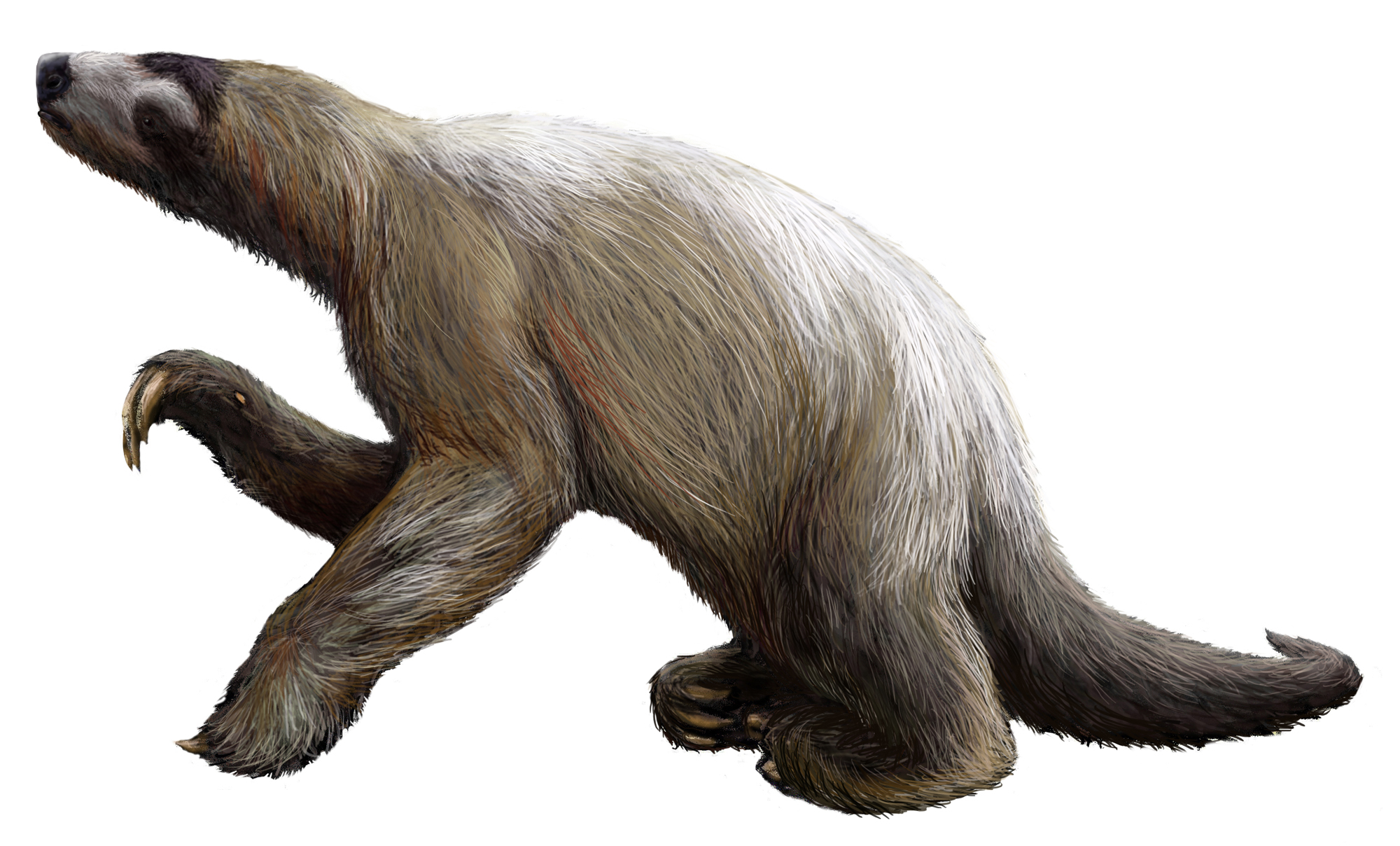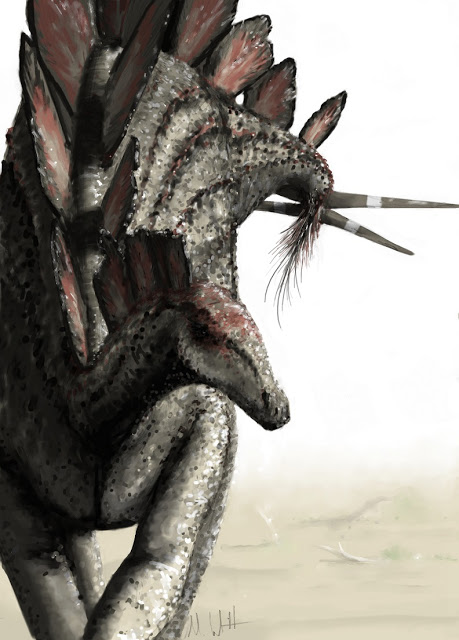 |
| Beautiful amateur artwork by yours truly. But why the fuzz? |
Xenarthra are a group of mammals exclusive to the Western Hemisphere. They include freaky animal families like Armadillos, Sloths, and Anteaters, as well as awesome extinct forms like Ground Sloths and Glyptodonts. They are bizarre on so many accounts relating to their anatomy, such as having vertebrae that articulate differently than any other mammal, their lack of tooth enamel, and don't even get me started about some of their unsavory habits, like the recently documented observations of Linnaeus's two-toed sloth drinking from human latrines (Heymann 2010). Yuck...
 |
| It suddenly seems a lot less cute after discovering about its drinking habits. I wonder how Kristen Bell reacted to that discovery... |
The thyreophoran taxa Scutellosaurus (Padian 2004), Stegosaurus (Redelstorff 2009), and numerous American ankylosaurs (Stein 2013) have all been shown to have slowed growth rates when compared to other dinosaurs. They weren't as slow as reptiles, but definitely not as fast-growing as mammals. This suggests that like xenarthrans, the Thyreophora had a metabolism slower than other dinosaur families. There is, however, the exception of Kentrosaurus, which might have had a faster growth rate (Redelstorff 2013). However, Kentrosaurus seems to have been an exception, and the majority of evidence points towards thyreophorans having lowered body temperatures like xenarthrans. Whether or not their actual body temperatures were at comparable levels to xenarthrans we don't know, but seeing as how many scientists now consider dinosaurs to be warm-blooded on the same level as modern mammals, similar thermoregulatory levels between thyreophorans and xenarthrans might be expected. I'd like to see someone try to test this idea in the future.
So, what does this all have to do with an Ankylosaurus having fuzz? Well, everything really. You see, the main argument made by people against the idea that large dinosaurs had feathers, or any type of fuzz really, is that they wouldn't need it, being large enough to be able to have a stable body temperature, as seen on modern large mammals. I have my own issues with this idea, since it assumes that protofeathers and hair are the same kind of structure (which they are not), and that dinosaurs have a similar physiology to mammals (which is unlikely). However, even assuming such ideas, we still know of large-bodied mammals that live in tropical regions which have thick, shaggy fur, and they're xenarthrans.
 |
| The Shasta Ground Sloth, a desert-dwelling sloth that was completely covered in shaggy fur. Other members of the group were the size of an Elephant and just as fluffy. |
So this would seem contrary to what people say about large mammals shedding fur at larger sizes. Why did ground sloths keep their shaggy fur in tropical environments at such large sizes while other groups of mammals of equivalent size lost their fur? Our best answer is that this was due to their lowered metabolism, which means they had a harder time holding onto body heat than other mammals. Apparently holding onto that hair was also a pretty smart move, especially since ground sloths back then were perfectly able to extend their range up into temperate regions of North America and even as far north as Alaska during the last Ice Age, while living sloths have trouble tolerating even temperate latitudes. According to McNab, this was probably due to a combination of their thick fur, as well as greater size, larger muscle mass, and a constant food supply compared to their living relatives (McNab 1985).
So assuming that ankylosaur growth rates suggest that they had lowered body temperatures like xenarthrans, might we then expect that these guys were covered in shaggy fuzz, too?
 |
| Stegosaurus with tail spines made of porcupine-like filaments. Art by Mark Witton. Looks like other scientists got the memo, or they're just slapping feathers on everything again... |
When you take all this into account, it almost makes the picture I drew kind of conservative, showing only short fuzz compared to the longer hair common on ground sloths. Perhaps I'm diving too deep into speculation right now, but I think that my idea holds some merit. What are your thoughts? As always I'd love to hear everyone's opinion on this.
Stay sharp! And make sure you check out my brand new Ankylosaur video on YouTube:
References:
Heymann, E. W., Flores Amasifuén, C., Shahuano Tello, N., Tirado Herrera, E. T. & Stojan-Dolar, M. 2010. Disgusting appetite: Two-toed sloths feeding in human latrines. Mammalian Biology doi:10.1016/j.mambio.2010.03.003
McNab, Brian K. (November 1980). "Energetics and the limits to the temperate distribution in armadillos". Journal of Mammalogy (American Society of Mammalogists) 61 (4): 606–627. doi:10.2307/1380307. JSTOR 1380307.
McNab BK (1985). Energetics, population biology, and distribution of Xenarthrans, living and extinct. In: Montgomery GG (Editor), The Evolution and Ecology of Armadillos, Sloths and Vermilinguas. Smithsonian Institution Press, Washington and London, 219-232.
Padian K, Horner JR, Ricqlès A (2004) Growth in small dinosaurs and pterosaurs: the evolution of archosaurian growth strategies. J Vert Pal 24: 555–571. doi: 10.1671/0272-4634(2004)024[0555:gisdap]2.0.co;2.
Ragna Redelstorff & P. Martin Sander (2009) Long and girdle bone histology of Stegosaurus: implications for growth and life history, Journal of Vertebrate Paleontology, 29:4, 1087-1099, DOI: 10.1671/039.029.0420
Redelstorff, R., Hübner, T. R., Chinsamy, A. and Sander, P. M. (2013), Bone Histology of the Stegosaur Kentrosaurus aethiopicus (Ornithischia: Thyreophora) from the Upper Jurassic of Tanzania. Anat Rec, 296: 933–952. doi: 10.1002/ar.22701
Stein M, Hayashi S, Sander PM (2013) Long Bone Histology and Growth Patterns in Ankylosaurs: Implications for Life History and Evolution. PLoS ONE 8(7): e68590. doi:10.1371/journal.pone.0068590